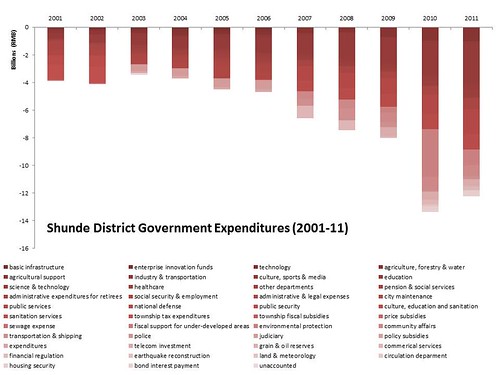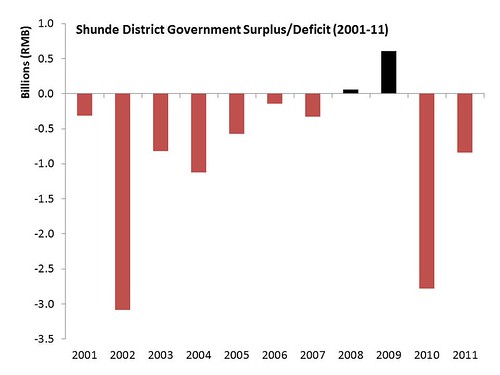
Last week, we visited Foshan to interview factories for a consulting project that Professor Huang Yasheng is doing for the Guangdong provincial government. One of our first stops in Foshan was to the ginormous Shunde District Government Office, which the locals have dubbed “Shunde White House.” The Communist Party of China has cited Shunde’s government office one of the more extravagant government office buildings. It also got me wondering: Where did the Shunde district government get the money to build the government office building? I checked Shunde district government’s fiscal budget for the past decade and came up with this graph:

It looks like Shunde district government’s revenues have been growing because they have been collecting more income tax from the companies in the region. Shunde’s government has benefited from having white goods manufacturer Midea based there. Midea accounts for 70% of the township’s GDP. Last year, Midea paid 5.2 billion RMB ($823.6 million) in taxes or almost 60% of Shunde’s income tax revenues, according to the Beijiao Economy Promotion Bureau.

Naturally, I then wondered where the Shunde District Government was spending all of its money (besides building huge government office buildings). Surprisingly, the number one expenditure by the Shunde District Government was in education. Last year, the Shunde district government spent 2.9 billion RMB or 22% of its total expenditures on education.

When I combined the two graphs of Shunde District Government’s revenues and expenditures, it turns out that Shunde has had a deficit in 8 out of the past 10 years. The only two years when Shunde didn’t report a deficit were in 2008 and 2009, which is a bit ironic since the financial crisis was pushed most other governments further into debt.
A lot of local governments took on debt in 2008 and 2009 to invest in transportation infrastructure projects to get through the financial crisis. The National Audit Office came out with a report in June 2011 estimating that China’s local government held a cumulative 10.7 trillion RMB ($1.7 trillion) in debt at the end of 2010. Some policymakers and academics in China have been starting to get a little concerned because 17.17% of the debt needs to be paid back last year and this year.




